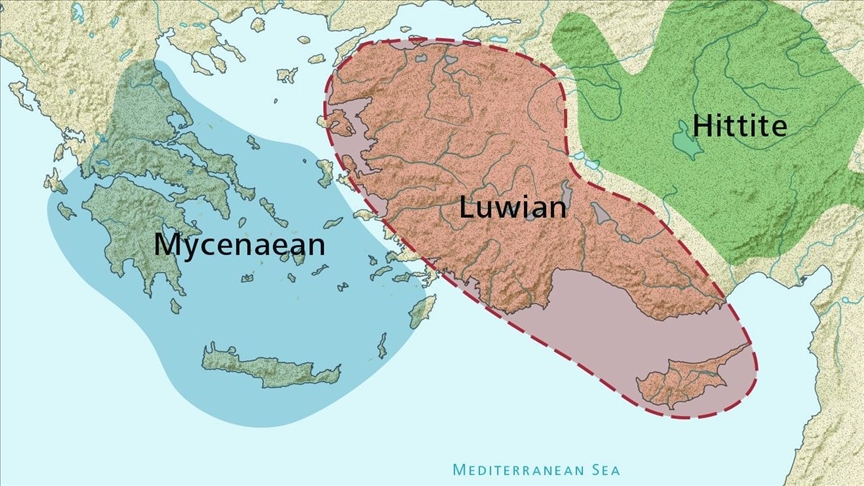Luwians of Türkiye: Unlocking an untold chapter of ancient history
Türkiye’s rich archaeological heritage holds 'endless possibilities,' says Swiss geoarchaeologist

- 'I believe that many significant discoveries are still waiting to be made,' says Eberhard Zangger
GENEVA
Hidden for centuries, the Luwian culture is emerging as a crucial piece of the ancient Anatolian puzzle, transforming our understanding of Türkiye’s Bronze Age.
Recent studies reveal that this overlooked culture not only shaped the political landscape of the Eastern Mediterranean but may also explain some of history's biggest mysteries, like the Trojan War and the fall of the Hittite Empire.
"If we examine a map of known cultures in the Eastern Mediterranean around 1200 BCE, we find that the western part of Türkiye remains conspicuously empty," Eberhard Zangger, a Swiss geoarchaeologist and the head of the Luwian Studies Foundation, told Anadolu in an interview.
"The Mycenaean civilization barely touched the Anatolian mainland, except for a few isolated ports of call, and the Hittites focused primarily on central Asia Minor, only occasionally asserting control over western territories. This fertile region, however, rich in natural resources, played a crucial role in the historical landscape," Zangger said, suggesting that without accounting for the Luwians, "we struggle to address key historical questions, such as the context of the Trojan War, which seems implausible without the Luwians – even as a piece of fiction."
He said the foundation's researchers have started piecing together clues about the Luwians, whose influence likely extended across hundreds of settlement sites in Türkiye dating to the time of the Trojan War.
"The Luwian Studies Foundation has highlighted a thriving Bronze Age culture with at least 483 large settlements, some inhabited for up to 5,000 years," he said.
While many of these sites remain untouched, he warns that “agriculture, construction and exposure are constant threats.”
Zangger emphasized that finding more royal centers beyond the well-known city of Troy could be revolutionary.
"Western Asia Minor had numerous small kingdoms, yet Troy is the only royal center we currently know. Finding another royal site – possibly with archives – would deepen understanding of Türkiye’s rich history and capture global attention," he said.
Western-centric narrative in archaeological discourse
Yet ancient Anatolia has long taken a back seat in archaeological research, Zangger noted. He explained that much of early Western European archaeology was heavily influenced by philhellenism, an 18th- and 19th-century movement that revered Greek culture and often framed European superiority in opposition to the Ottoman Empire.
This bias, Zangger said, led to a Western-centric narrative that still dominates archaeological discourse today.
"At that time, archaeological efforts by Western European scholars were often aimed at legitimizing European dominance, reinforcing the notion of Western superiority and justifying the exploitation of foreign cultures during colonialism," he said. "This perspective helped to unite a politically fragmented Europe in its opposition to the Ottoman Empire."
Although these "outdated values" have largely been discredited, many of the structures and paradigms established during this era remain entrenched, particularly in textbooks, he added.
In contrast, the study of Luwian culture, Zangger noted, is pioneering a new, science-driven approach free from colonial biases.
He said the Luwian Studies Foundation, a private non-profit initiative, has been instrumental in this shift, adding: "As a result of the foundation’s work, we now have a clearer picture of what happened in the Eastern Mediterranean around 1200 BCE, and we can trace the events that ultimately led to the decline of various Bronze Age cultures."
Türkiye's archaeological heritage holds 'endless possibilities'
Zangger believes that Türkiye’s rich archaeological heritage holds "endless possibilities" for uncovering new insights into the Bronze Age. Despite centuries of focus on Greek and Roman sites, he insists that Bronze Age Anatolia still holds countless untold stories.
"I believe that many significant discoveries are still waiting to be made, particularly since most excavations have primarily focused on Greek and Roman sites," he said.
"While our understanding of Bronze Age Anatolian cultures remains limited, we do have some intriguing clues to the region’s great archaeological mysteries."
As interest grows, Zangger stressed that preserving these archaeological sites is a vital responsibility.
"The remarkable preservation of many of these sites is a blessing but also a responsibility," he said.
To further explore the Luwian sites, Zangger said he believes that advanced technology could hold the key.
“We can now use aerial surveys with drones and helicopters to study various sites. If we obtain the necessary permits, these initial projects could lead to groundbreaking findings," he said.
For instance, aerial scans of the Plain of Troy could reveal the full extent of the ancient city, and a detailed photogrammetric model of the Yazilikaya rock sanctuary could be integrated into astronomy software to understand its alignment with the stars, according to the geoarchaeologist.
By utilizing these modern techniques, he said: "We can effectively enhance the visibility of Türkiye’s rich cultural history beyond the well-known Greco-Roman sites."
Anadolu Agency website contains only a portion of the news stories offered to subscribers in the AA News Broadcasting System (HAS), and in summarized form. Please contact us for subscription options.







